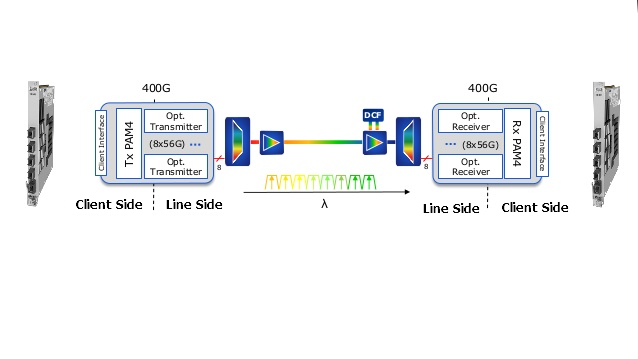
Il passaggio ai servizi cloud e alle reti virtualizzate ha messo il data center nel mezzo del nostro mondo e ha significato che la connettività all’interno dei data center e tra i data center ha un enorme impatto sulla fornitura di servizi aziendali e personali. I data center Hyperscale vengono installati in tutto il mondo e questi hanno tutti bisogno di essere connessi. Per soddisfare questa domanda, i fornitori di ricetrasmettitori ottici stanno offrendo nuove soluzioni basate su PAM4 e 64QAM, fornendo una modulazione coerente che ridurrà il costo della connettività e aumenterà la larghezza di banda di ciascuna connessione.
Le connessioni a molti server sono già 25G e i collegamenti tra switch in data center di grandi dimensioni sono già 100G. L’introduzione dei transceiver SFP28 e QSFP28 che integrano le nuove tecnologie e sono state costruite utilizzando tecniche di produzione efficienti hanno ridotto il costo di queste connessioni e consentito una crescita massiccia nel mercato. La fase successiva è l’introduzione di soluzioni a singola lambda 100G e ricetrasmettitori a basso costo 400G per i collegamenti tra switch. I dispositivi PHY necessari per questo passaggio successivo sono già disponibili, i dispositivi switch da 12,8T sono in produzione e i primi ricetrasmettitori ottici QSFP-DD e OSFP 400G sono di campionamento.

L’ascesa dell’operatore di data center hyperscale ha cambiato radicalmente il mercato. Il passaggio a 25G e 100G da 10G e 40G è avvenuto molto rapidamente. L’ampiezza e il numero di data center installati o aggiornati significa che le nuove tecnologie possono essere spedite in volume non appena il prezzo è giusto, i componenti sono stati qualificati e le linee di produzione sono operative. Ora stiamo vedendo i primi dispositivi 400G PHY e ricetrasmettitori ottici per la disponibilità di data center e le aziende stanno gareggiando per la posizione di mercato in attesa che i principali operatori hyperscale si impegnino a implementazioni di grandi dimensioni.
Molte di quelle aziende che hanno beneficiato di 25G e 100G stanno investendo i propri investimenti in soluzioni Lambda PAM4 100G e 400G per il data center . Ciò ha richiesto nuovi dispositivi PAM4 PHY progettati per soddisfare i limiti di potenza dei transceiver OSGP e QSFP-DD 400G. Alcune aziende hanno anche investito in PHG 50G e 200G PAM4, consentendo un aggiornamento economico da 25G e 100G. Si prevede che i ricetrasmettitori 50G SFP56 e 200G QSFP56 siano soluzioni provvisorie, ma non è chiaro quanto sia diffuso il loro uso o per quanto tempo. 40G è stata una soluzione provvisoria che è durata per molti anni.
La tecnologia coerente, originariamente sviluppata per reti a lungo raggio da 100G, è ora ampiamente utilizzata per le connessioni a lungo raggio, comprese le reti sottomarine, metropolitane e Data Center Interconnect (DCI) tra i data center. Il mercato per DCI è cresciuto rapidamente, con molti fornitori di sistemi che offrono soluzioni con una copertura da 80 a 500 km. Per le applicazioni a lungo raggio e metropolitane, numerosi produttori leader di apparecchiature continuano a utilizzare progetti di DSP (Digital Signal Processor) coerenti all’interno dell’azienda. La soluzione coerente DSP è ora disponibile per i fornitori di ricetrasmettitori ottici come Gigalight che invierà transceiver 400Gbasato su questo disegno. Gli ultimi ASIC DSP stanno abilitando le soluzioni 600G (64Gbaud 64QAM) e i transceiver CFP2-DCO. Il passo successivo è l’introduzione dei DSP 7nm che consentiranno l’utilizzo di transceiver ZR 400G a costi contenuti per collegamenti 400G fino a 100 km a partire dal 2020.
Questo continua ad essere un mercato in divenire. Lumentum ha completato l’acquisizione di Oclaro, Cisco ha completato l’acquisizione di Luxtera e diversi fornitori di ricetrasmettitori ottici cinesi hanno aderito alla carica di 400G nel data center. I dispositivi PAM4 PHY richiesti per 100G single lambda e 400G nel data center si stanno dimostrando molto impegnativi da consegnare. Le soluzioni PAM4 PHY in tecnologia a 28 nm e 14/16 nm sono state sottoposte a campionamento per oltre sei mesi e ora vengono affiancate da soluzioni 7nm.
Articoli correlati: PAM4 — The High-Speed Signal Interconnection Technology of Next-Generation Data Center

